12 Creative Add-Ins For Your Glass Of Champagne
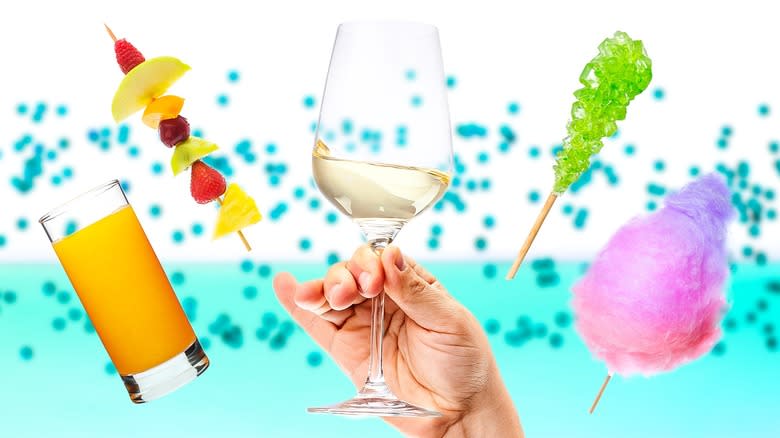
Planning a champagne toast for your next gathering presents an exciting opportunity to infuse creativity and personal touches into this celebratory tradition. While you might already have a preferred champagne brand or variety, there are numerous unique additions you can incorporate to create a more memorable experience. From delightful garnishes that enhance flavor to special accenting liquids that transform your champagne into an extraordinary cocktail, the array of options is rather extensive. The challenge lies not in finding these additions, but in deciding which ones to choose.
However, there's no need to limit yourself to just one option. It's your party, after all, so you get to make the rules here. Why not set up a champagne add-in buffet? This allows guests to experiment and combine different elements, crafting their own personalized champagne concoctions. It's a playful and interactive way to engage everyone at your event.
For the younger or non-drinking guests, consider offering non-alcoholic alternatives like sparkling grape juice. They too can enjoy customizing their drinks with various non-alcoholic additions. Not to mention, this inclusivity ensures that when the celebration peaks, everyone, regardless of age or drinking preference, can participate in the toast with a glass uniquely tailored to their tastes and comfort level.
Read more: The 40 Absolute Best Cocktails That Feature Only 2 Ingredients
Cotton Candy
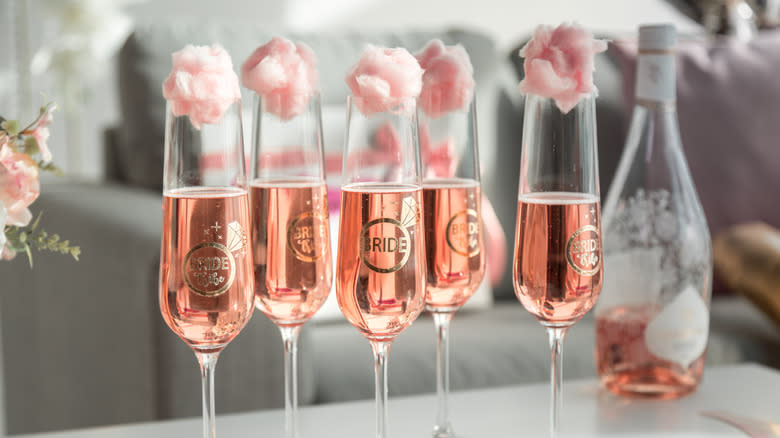
For a sugary, nostalgic twist to your champagne, place a tuft of cotton candy at the bottom of your flute before pouring champagne over it. Watch the enchantment unfold as the cotton candy dissolves seamlessly into the champagne, imbuing it with a delightful sweetness. This presentation is most effective when glasses are pre-filled with cotton candy but initially left without champagne. This staging allows guests to witness the mesmerizing moment when the effervescent champagne dissolves the airy cotton candy.
This sweet treat originally called "fairy floss" dates all the way back to 1897 (and the inventor of cotton candy might surprise you), before it hit the big time at the 1904 World's Fair. Today you can find it at carnivals, theme parks, parties, bachelorette celebrations, and even gatherings with rented cotton candy equipment. To help keep the champagne balanced in this concoction, you may want to use dry champagne, since the cotton candy will certainly sweeten the whole deal.
To make the experience even more visually appealing, keep an extra bowl of cotton candy on hand. After pouring the champagne, gently place a small amount of cotton candy on top of each glass as a garnish. This creates a stunning visual effect that is perfect for photographs while adding an extra layer of sweetness and texture.
Edible Glitter
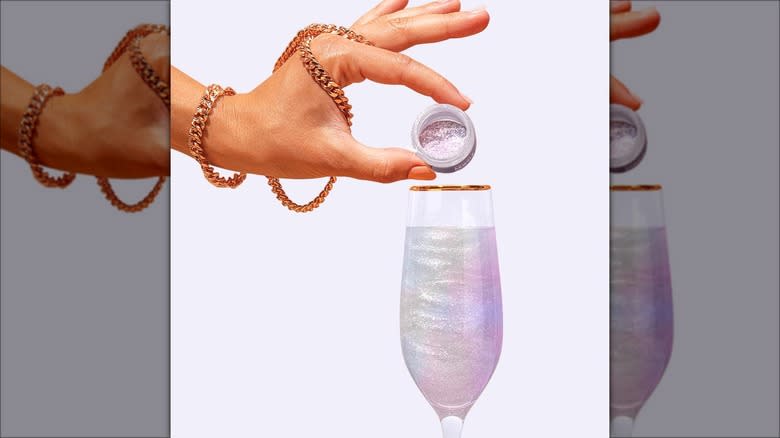
Glitter isn't just for crafts — it's also a fun and fabulous addition to beverages. Edible glitter, available in a dazzling array of colors and mixes, brings an extra touch of sparkle to your champagne.
To create a mesmerizing effect in your champagne, simply take a small scoop of the glitter and pour the champagne over it. This combination results in a swirling, shimmering cloud, adding another layer of festivity to your toasts. For a twist on this sparkly addition, consider wrapping edible glitter inside cotton candy before placing it in the drink. As the cotton candy melts, it unveils the hidden glitter, creating a magical reveal.
This technique can elevate themed parties, like a Hogwarts house celebration with the glitter signifying a Gryffindor, Hufflepuff, Ravenclaw, or Slytherin house assignment. It's also perfect for gender reveal parties, adding a surprise element for guests.
When selecting glitter colors, consider how they will visually pair with the champagne. For instance, gold or silver glitter can complement the golden hues of traditional champagne, while vibrant colors can add a bright, eye-catching contrast. Always remember that an essential part of using edible glitter safely is to check if it's labeled as edible food grade, to ensure that your glittery champagne is stunning and safe to enjoy.
Herbs
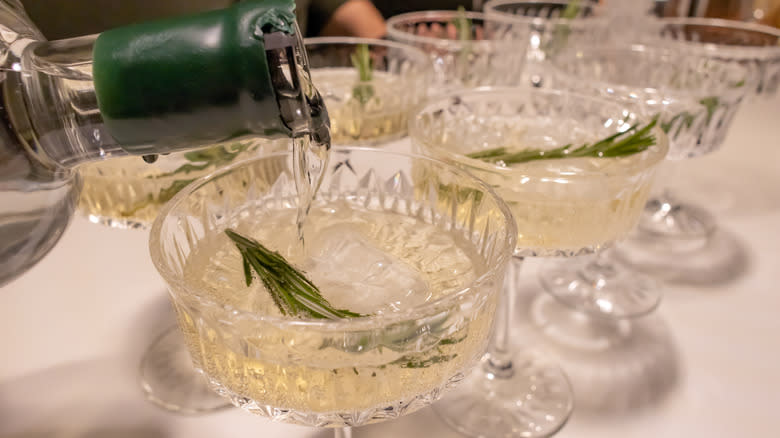
Pretty green herbs always make a nice accent, especially when paired with the effervescence of champagne. We love the idea of making champagne garnishes ultra-simple while offering guests a variety of options to choose from. When you're at the store, select some of the best-looking herbs you can find. We particularly recommend pulling fresh rosemary, mint, and even basil for their vibrant colors and distinct flavors.
When it's time to garnish your champagne glasses, arrange your herbal offerings on a platter so your guests can choose which herbs they'd like to include in their drink. They'll likely make their pick based on their favorite flavors, but don't be afraid to offer your favorite recommendation from the bunch. To us, rosemary is one of the best herbs to include in champagne, especially for a New Year's Eve toast. Its resemblance to a miniature Christmas tree feels just holiday enough to ride that line between putting away the tree for the season and looking ahead to the hope of a new year.
As you prepare these herbs, ensure they are clean and presentable. A gentle wash and pat dry will suffice. Each herb brings its unique character to the champagne. Rosemary offers a woody, evergreen scent, while mint adds a refreshing twist, and basil offers a sweet, distinct, slightly peppery flavor.
Chambord
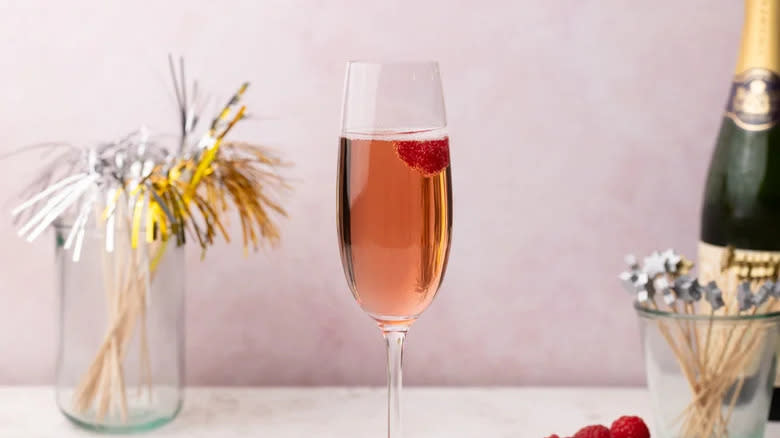
If you're looking for a change from the traditional champagne toast, the Kir Imperial cocktail offers a delightful twist. This cocktail is wonderfully simple to create, requiring no special equipment like a shaker or stirrer. All you need are two key ingredients: champagne and Chambord, a delicious, even luxurious, raspberry liqueur.
Begin by pouring an ounce and a half of Chambord at the bottom of a flute glass. Then, top it with chilled champagne. The beauty of this cocktail lies in its simplicity and the richness that Chambord brings to your new go-to bubbly drink. If you want to add a bit more flair, consider garnishing with a few raspberries to float right on top. They will enhance the visual appeal and complement the raspberry notes of the Chambord.
The Kir Imperial is a variation of the classic Kir cocktail, which traditionally combines crème de cassis and wine. Replacing the wine in the original Kir with champagne, and the crème de cassis with Chambord, gives this version a more special feel, perfect for celebratory occasions like New Year's Eve. You'll find that Chambord's deep, fruity flavor transforms the champagne into something truly extraordinary. It's not surprising to find that after trying a Kir Imperial, it might become a preferred choice well after the ball drops on New Year's Eve.
Angostura Bitters
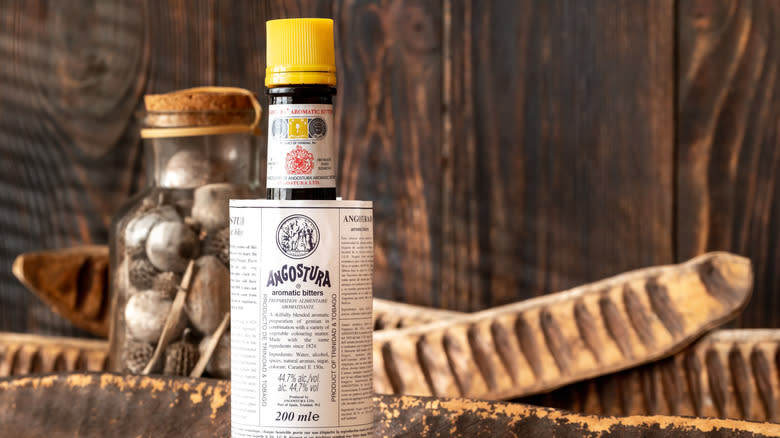
While many are familiar with Angostura bitters being a key ingredient in classic cocktails like the old fashioned and the Manhattan, this aromatic liquid's versatility extends far beyond these staples. In fact, bitters can be a fantastic addition to champagne, creating a unique and sophisticated cocktail.
When you use bitters, you'll notice warming spice flavors and gentian root, all from those little drops of big flavor. These distinct tastes might seem at odds with champagne's light and crisp nature, but they can actually enhance sparkling wine with just the right amount. The bitters introduce a complexity to the champagne, balancing its effervescence with a depth of flavor. Champagne, poured over a combination of sugar and Angostura bitters, proves that you don't need much to transform champagne into a delicious cocktail. The combination of the herbal, bitter notes of the Angostura and the sweetness of the sugar, topped with the bubbly texture of champagne, results in a refreshing and intriguing cocktail.
Orange Juice
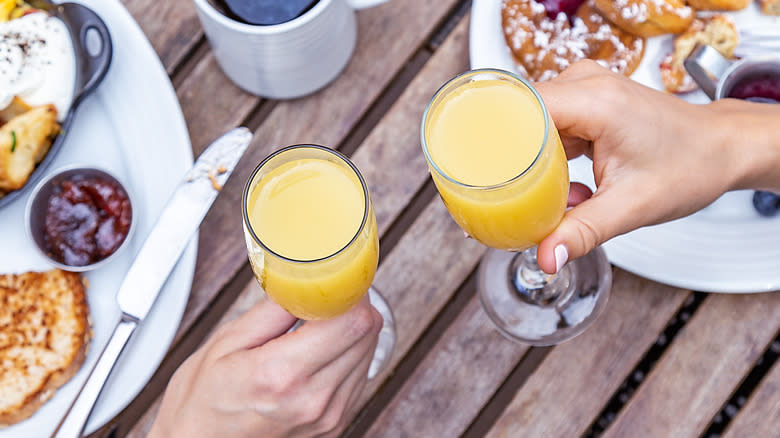
When you begin brainstorming what to add to champagne, orange juice is likely at the top of that list. The fruity mimosa, a beloved blend of orange juice and champagne, is a staple at brunch gatherings, wedding preparations, and celebratory showers. To create some of the juiciest mimosas you've ever enjoyed, consider doubling down on the orange juice in ice cube form.
You'll need an ice cube tray; both fun shapes and standard cubes will work. Pour the same type of orange juice you plan to mix with your champagne into these trays and freeze them. As these orange juice cubes melt in your mimosa, they gradually bulk up the drink, making it juicier and sweeter with every sip.
When it's time to assemble your mimosas, start by placing the orange juice ice cubes in a glass. Then, pour over your preferred mix of orange juice and champagne. This method keeps your mimosas cold and prevents them from becoming diluted as the ice melts. It's a simple way to ensure every sip is as flavorful as the first, if not more so. Plus, the visual appeal of orange juice ice cubes can add an extra touch of elegance to your event. One thing's for sure: Your guests may enjoy this trick so much that they begin using it themselves.
Pureed Fruit Ice Or Frozen Fruit
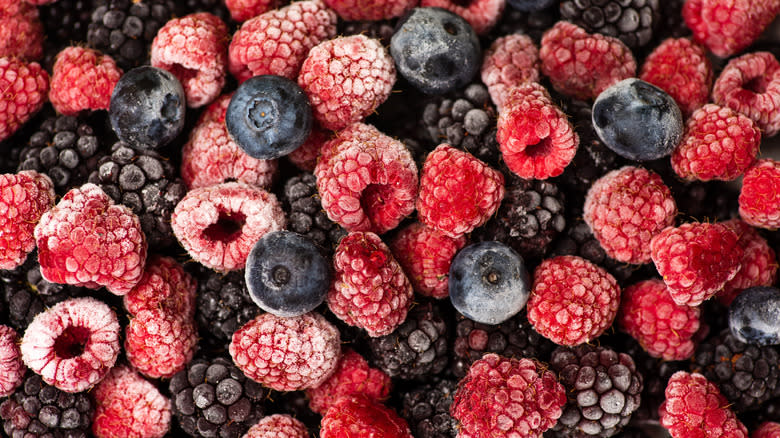
In much the same way that you can freeze orange juice for mimosas, freezing fruit purees into fun shapes to include in champagne is another way to bring in a burst of flavor and creativity. For this, you'll need fresh fruit that you've sliced or chopped, along with a little bit of water to create the right consistency in a blender or food processor. Aim for a puree that maintains a bit of texture, then pour your puree right into ice cube molds.
Depending on the type of gathering, you might choose specific types of fruits or shapes to match the theme. For instance, add a seasonal touch during Thanksgiving with leaf- or pumpkin-shaped molds filled with purees that resemble the rich colors of falling leaves and orange gourds. For an Independence Day celebration, consider using a star-shaped ice cube mold and freezing purees of blueberries and strawberries for patriotic flair.
Once your fruit purees have had enough time to freeze, pop them out of the trays and place the frozen fruit shapes into glasses. This add-in creates a pop of color and a touch of delight to your champagne, and slowly infuses it with fruity flavors as the puree melts.
An alternative to this is using fruit that has been frozen. This will mean you are freezing whole or chopped fruits rather than pureeing them and pouring them into molds. Then, pour your champagne right over that frozen fruit.
Fruit Kebabs
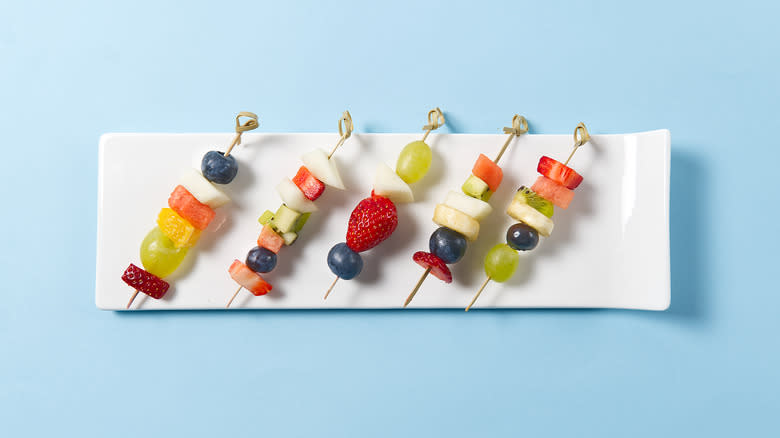
You're probably familiar with the traditional kebabs you put on the grill, with stacks of meats cooking together over a flame, enjoyed by pulling them off the skewer. In much the same way, you can create fruit kebabs, which involve skewering a variety of fruits together. Typically seen as an appetizer option, we believe their potential extends much further. Just as fruit-infused ice enhances champagne, fruit kebabs also have a place at the table in a champagne setting.
Of course, the choice of fruit will depend on the season and the specific celebration you're preparing for. You can select colors and types of fruits to create a theme, or go for an assortment of varieties to give your guests plenty of options. Imagine skewers with vibrant berries, juicy melons, and tropical fruits arranged in an eye-catching display.
The best part is, as your guests enjoy their champagne, they can pull out a kebab and nibble on a bit of champagne-infused fruit. This adds a fun, interactive element to the experience and allows the fruit to subtly absorb the champagne's flavor, creating a delightful taste combination. When preparing these fruit kebabs, we recommend choosing fruits that taste great and hold up well on a skewer, like grapes, apples, pineapple chunks, strawberries, and kiwi slices.
Stout
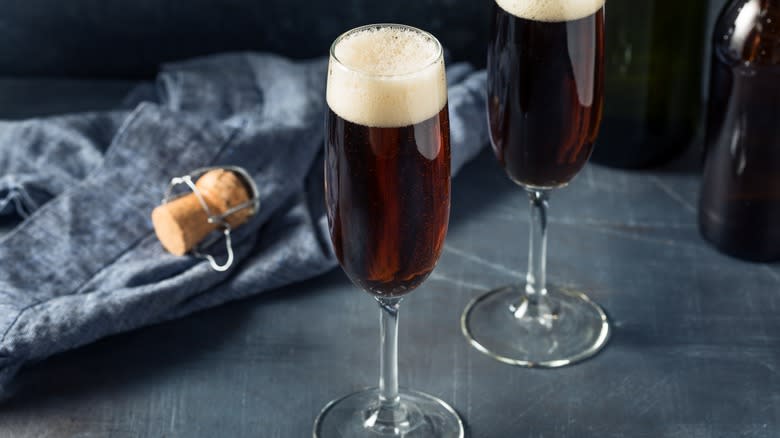
You may be familiar with the black and tan, a classic beer cocktail made with a mix of Harp and Guinness. When poured correctly, it has distinct color layers — the Guinness providing the black and the Harp providing the tan. As you drink it, the two layers remain mostly separate, allowing you to savor the smoothness of Guinness combined with the lightness of Harp.
In a similar fashion, you can enjoy a unique combination with champagne, known as the black velvet. This cocktail — pairing dark, rich stout with light, bubbly champagne — results in a truly memorable and unique drink. The black velvet is straightforward to make, consisting of equal parts champagne and stout, typically Guinness.
The champagne and the stout should be well-chilled before mixing, because room temperature won't do for this cocktail. To assemble a black velvet, start by pouring champagne into a glass. Then, carefully add the stout. To maintain the distinct layers, pour the Guinness slowly over the back of a spoon on top of the champagne. This extra step and slow pour helps in creating a clear separation between the two, much like you may have seen in a black and tan.
Rock Candy
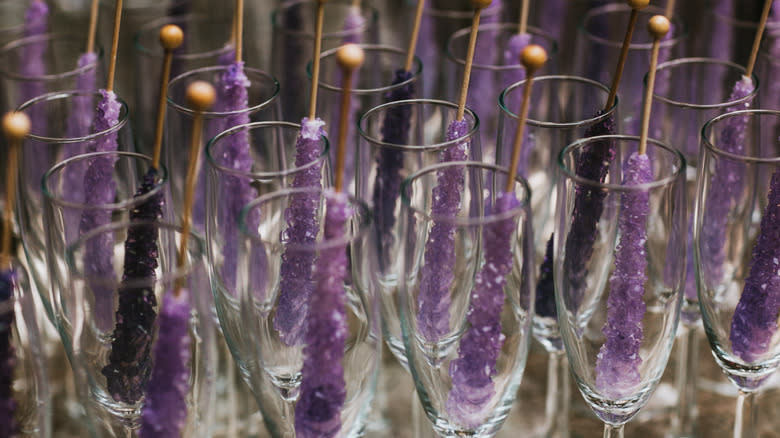
Cotton candy isn't the only sugary treat that pairs well with champagne. Consider using rock candy on sticks as a garnish for a childlike, sparkly, and whimsical-yet-sophisticated touch. Like cotton candy, rock candy is available in many colors, allowing you to match it to the theme of your celebration or offer a variety of options for guests to personalize their champagne flutes.
One of the charming aspects of rock candy is how its crystal structure interacts beautifully with the effervescence of champagne. The bubbles cling to the crystals, creating a dazzling visual effect. Additionally, as the rock candy dissolves, it subtly sweetens the champagne, adding a new dimension to the drink's flavor.
The length of rock candy sticks is perfect for champagne flutes. They protrude just enough to serve as an enticing garnish while immersing most of the candy in the bubbly. This enhances the aesthetic appeal and ensures the candy infuses its sweetness evenly throughout the dissolving process.
Sugar Cubes
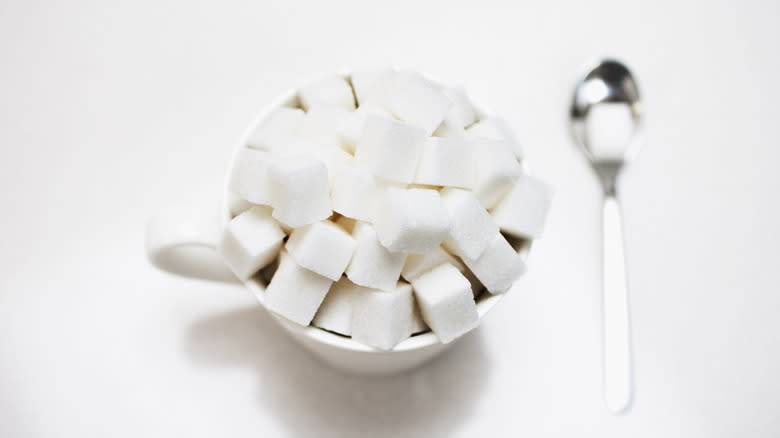
Champagne is a common drink for celebrations, especially around New Year's Eve, but not everyone is a fan. After all, unless you opt for a sweeter variety, champagne can be a bit on the dry side. To remedy this, we recommend the simple addition of a sugar cube. This little cube works wonders — it sweetens the champagne and creates a beautiful effect with bursts of bubbles shooting right to the top of your glass. It certainly makes the moment all the more special.
Additionally, there's a charming aspect to this rooted in Italian superstition. It's said that people drop sugar cubes in a glass of champagne to make the moment even sweeter, with a sugar cube bringing even more happiness to the situation and keeping the devil's evil influence at bay. This small gesture can make a significant difference, especially for those who might otherwise shy away from a glass of dry bubbly.
Hibiscus
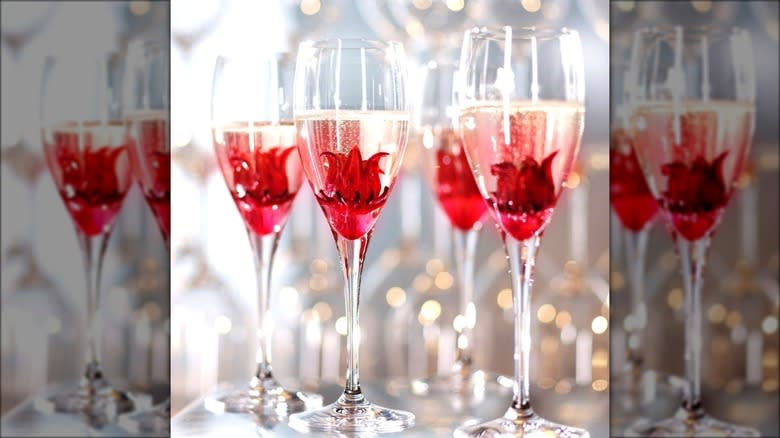
Flowers have long been used to beautify cocktails, usually serving as a garnish atop a drink or on its rim. However, the Wild Hibiscus Flower Company offers a truly unique twist on this tradition. With its Wild Hibiscus Flowers in Syrup, you can elevate your champagne experience to an entirely new level.
This product enables you to enjoy a beautiful flower at the bottom of your drink by simply placing a hibiscus flower at the bottom of a champagne flute and then pouring champagne over it. As you serve the drink, the hibiscus releases its brilliant red hue into the glass. Available in jars containing either 11 or 50 flowers, these hibiscus blooms cater to events of any size, whether it's an intimate gathering or a large celebration.
The flower is totally edible, and will have a texture and firmness that may remind you of a slightly chewy dried cranberry. The flavor it imparts will be a subtle sweetness. Of course, if the prospect of putting a flower right in your champagne feels a little too over the top, you can always offer a few fresh flowers to delicately drape over the edge of the glass to create an equally lovely effect.
Read the original article on Tasting Table.

